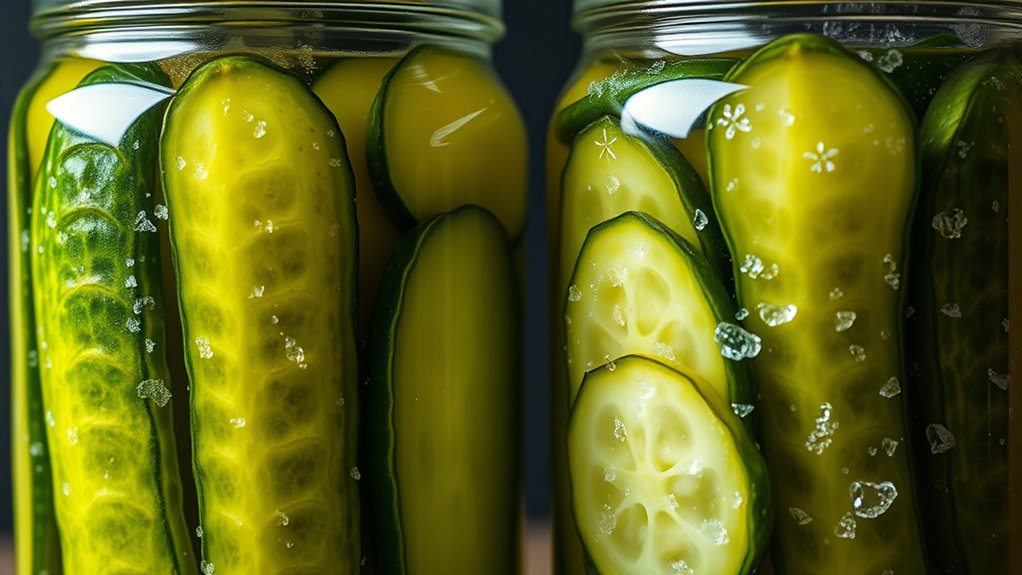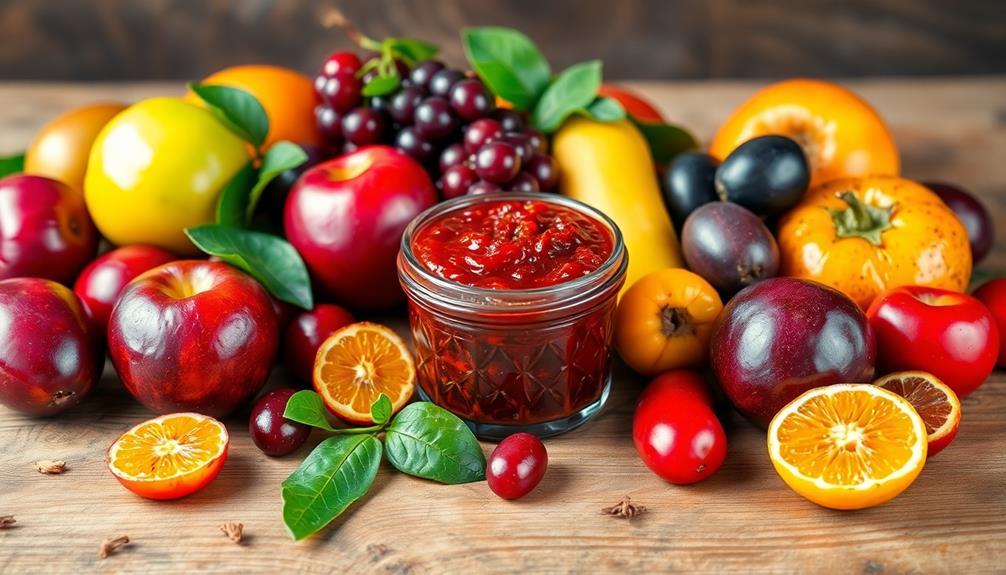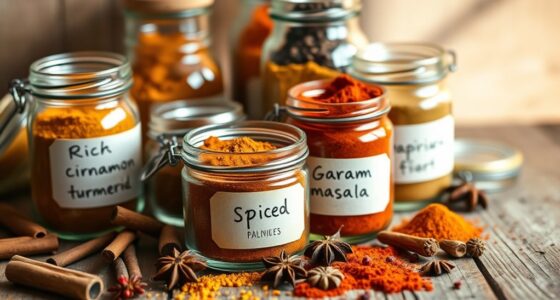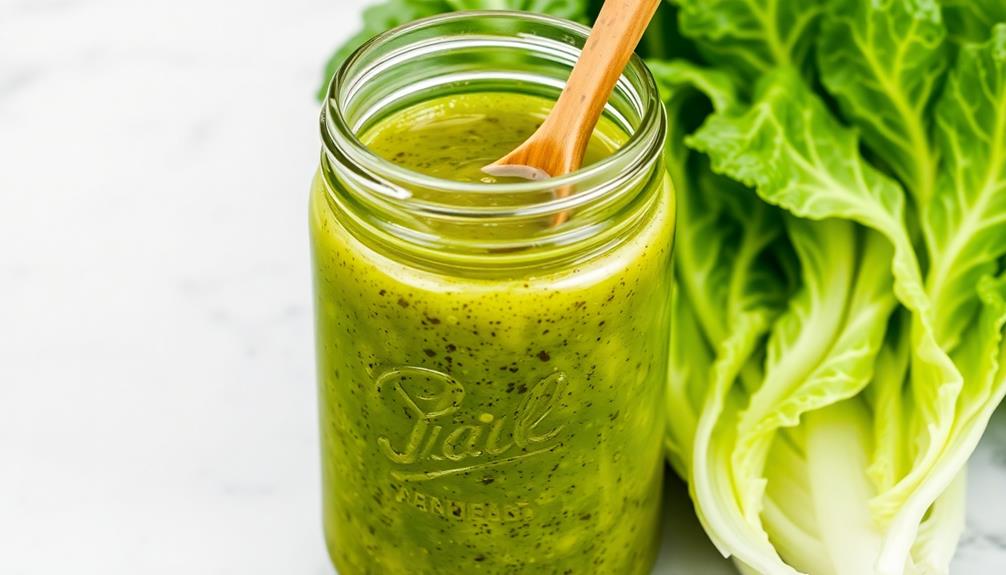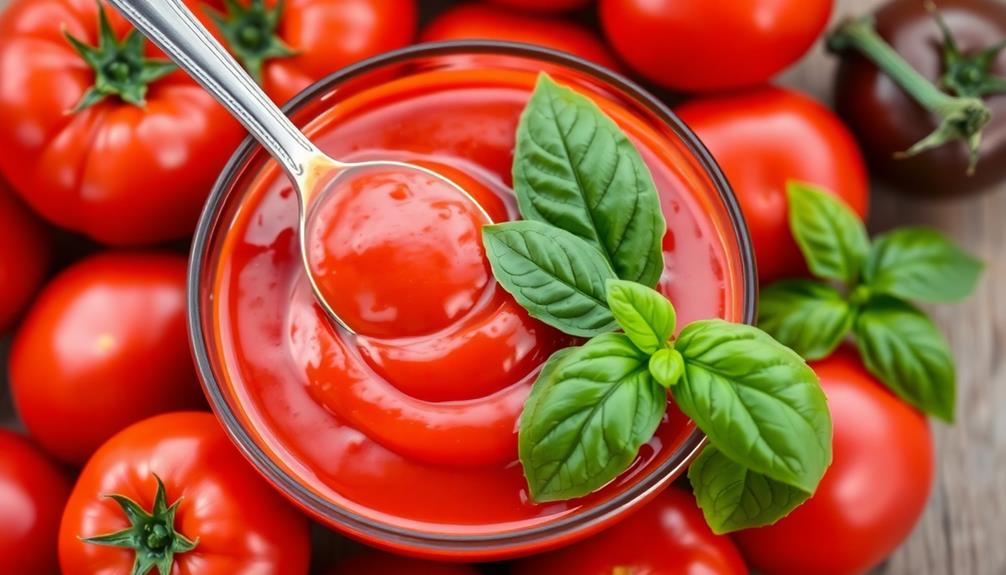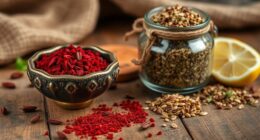When pickling cucumbers, calcium and alum influence crunchiness differently. Calcium strengthens the cell walls by interacting with pectin, providing natural, lasting firmness during fermentation. Alum reacts with water inside the cells, creating immediate surface crunch but risking internal damage and less longevity. If you want a reliable, long-lasting crispness, calcium is your best bet. To discover how these agents work and which suits your taste, keep exploring the science behind crunchy pickled cucumbers.
Key Takeaways
- Calcium strengthens cucumber cell walls by binding with pectin, supporting long-term firmness during fermentation.
- Alum reacts with water inside cells to create immediate crunch but can damage cellular structure over time.
- Calcium promotes natural preservation of crispness, maintaining texture without altering taste.
- Alum provides quick surface crunch but may lead to brittle or compromised internal cellular integrity.
- Proper fermentation conditions and additive choice influence the durability and quality of the pickled cucumber’s crunch.
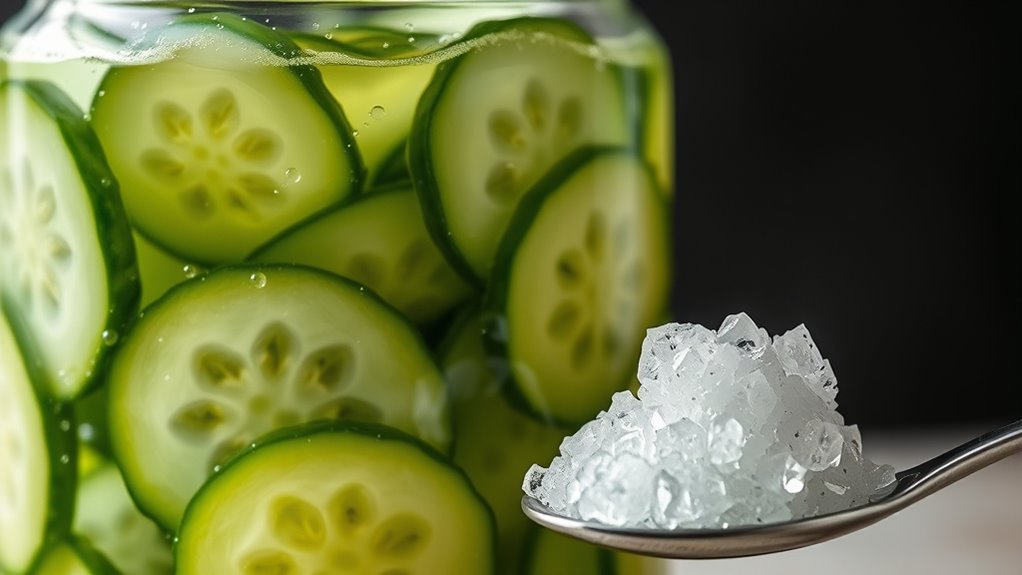
Have you ever wondered why some pickled cucumbers stay irresistibly crunchy while others turn soft? The secret often lies in the fermentation process and how it influences texture preservation. When you pickle cucumbers, you’re essentially creating an environment where beneficial bacteria ferment the vegetable, producing lactic acid. This fermentation process not only preserves the cucumbers but also helps maintain their firm, crisp texture. During fermentation, the natural pectin and cellular structure of the cucumber are preserved, which is key to crunchiness. If the process is hurried or temperature conditions aren’t ideal, the cucumbers can become limp and lose their desirable crunch.
One of the most common debates in achieving that perfect crunch involves using calcium chloride (calcium) or alum (alum). Calcium plays a crucial role in texture preservation because it interacts with the pectin in the cucumber’s cell walls, strengthening them. When you add calcium to your pickling brine, it reinforces the cell walls, preventing them from breaking down during fermentation. This ensures the cucumbers retain their firmness over time, even after extended storage. Calcium’s effect is subtle but significant; it works within the natural structure of the cucumber, supporting the integrity of the flesh without altering taste. Additionally, calcium’s role in cell wall integrity is well-documented in plant physiology, which explains its effectiveness in preserving crispness. The natural reinforcement provided by calcium helps the cucumbers maintain their crunch without compromising their flavor. Moreover, calcium can be added at various stages of the pickling process, offering flexibility for home picklers.
Calcium strengthens cucumber cell walls, ensuring firm, long-lasting crunch during fermentation.
In contrast, alum, or potassium aluminum sulfate, is often used for its crisping properties, but it functions differently. Alum reacts with the water inside the cucumber cells, creating a firm, crunchy texture quickly. However, its mechanism can sometimes be more aggressive, leading to a surface that’s very crisp but potentially damaging the internal cellular structure if used excessively. Alum can give you an immediate crunch, but it doesn’t necessarily promote a natural or long-lasting firmness like calcium does. Additionally, some people prefer to avoid alum because of concerns about its safety or potential health effects, especially with prolonged consumption.
Ultimately, the choice between calcium and alum depends on your goals for texture and your preference for natural preservation methods. Calcium works gradually within the fermentation process, helping preserve the cucumber’s natural crispness over time, making it a popular choice for traditional pickling. Alum provides quick results but may not support long-term texture preservation and can be more intrusive to the vegetable’s natural structure. Understanding how each agent interacts with the cucumber’s cellular makeup helps you decide which method will give you that perfect, crunchy bite you’re after. Proper technique, including controlling fermentation conditions and choosing the right additive, makes all the difference in producing irresistibly crunchy pickled cucumbers. Proper technique and careful ingredient selection are essential for achieving the desired texture in your homemade pickles.
Frequently Asked Questions
Can I Substitute Alum With Other Preservatives?
You can definitely explore alternative preservatives to replace alum in pickling. Common options include calcium chloride, which helps maintain crunchiness, or natural options like grape leaves for flavor enhancement. Just keep in mind that each preservative affects texture and taste differently. When choosing an alternative, consider how it will influence your pickles’ flavor and crunch, ensuring you get the desired results without compromising quality.
How Does Calcium Impact Pickling Flavor?
Imagine calcium as a silent artist enhancing your pickles’ character. Its benefits go beyond crunchiness, subtly boosting flavor enhancement and preserving that fresh tang. When you add calcium, you’re inviting a gentle harmony that keeps the cucumbers crisp and flavorful without overpowering their natural taste. Calcium’s role is like a fine brushstroke, enriching your pickles with a balanced, satisfying flavor that keeps everyone coming back for more.
Are There Health Risks Associated With Alum?
You might wonder about alum safety and health concerns when pickling. Alum, used to keep cucumbers crunchy, can pose health risks if consumed in large amounts, such as gastrointestinal issues or kidney problems. Although small quantities are generally considered safe, it’s best to use alum sparingly. Always follow proper guidelines to minimize health concerns, and consider alternatives like calcium for a safer, crunchy pickle.
What’s the Best Way to Maintain Crunchiness Long-Term?
Think of your pickles as treasure chests that need the right care to stay crisp. To maintain crunchiness long-term, master pickling techniques that include proper brine concentration and temperature control. Store your jars in a cool, dark place, and guarantee lids are sealed tightly. These storage methods lock in freshness. Regularly check your jars and adjust techniques as needed, so your pickles remain as crunchy as the day you made them.
Do Different Cucumber Varieties Affect Crunchiness?
You’ll find that cucumber variety markedly impacts crunchiness, as different types have distinct texture differences. For example, pickling cucumbers tend to stay crisp longer, while slicing varieties might soften faster. When choosing cucumbers, consider their natural firmness and water content. By selecting the right variety, you can enhance your pickles’ crunch and enjoy a satisfying texture every time.
Conclusion
So, next time you’re biting into that perfectly crunchy pickle, remember it’s all about calcium and alum—because who knew your snack had a chemistry lesson? Maybe it’s time to ditch the fancy preservatives and embrace the natural crunch, or keep trusting the science that keeps your snack satisfying. After all, if you’re going to battle sogginess, might as well arm yourself with some chemistry knowledge—your taste buds will thank you!
